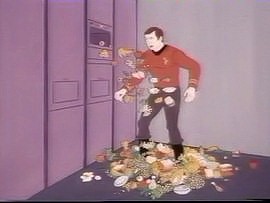Food has historically brought us together, but will 3D food printing cause us to lose those connections?
The development of 3D (three-dimensional) printer technology has led to some spectacular things from customized tools to cars. The process of printing layer on top of layers has turned regular 2D paper printers into a 3D world of opportunity. The first 3D printer prototype was patented in 1980 and has grown in usefulness and popularity. In 2012, a team at Cornell University conceptualized food printing with hydrocolloids. Since we have yet to achieve Star Trek’s food replicator standards, we’re a long way from ordering our food synthesizer to instantly produce a cup of raktajino or a fresh dish of gagh. The question is whether 3D food printing will become the wave of the future or another dud kitchen appliance?
What is food printing?
Food printing is an edible version of 3D printing which prints layers of edible ‘ink’ over and over again, forming multiple layers of ‘ink’ (food in this case), making it three-dimensional as shown below. The printers ‘ink’ nozzle allows it to move along 3 axis, unlike the nozzle of printers which print horizontally, while the paper is fed through. One limitation of 3D is that the nozzle currently only prints ‘inks’ that are either liquid or paste, meaning the food needs to dry or be cooked prior to eating.
Why print food?
After WWII, food ration production lines transitioned into processed food lines, changing how people shopped for groceries, prepared meals and what they ate. Most processed foods are generally produced through large-scale machinery, therefore the adoption of 3D printing isn’t unexpected. The Italian food company, Barilla has already begun printing beautiful 3D pasta designs which can’t easily be constructed by hand or pasta presses. Bakeries, confectioneries, and commercial kitchens have introduced technology to print intricate designs. When it comes to constructing sugar structures, complex chocolate work, or tedious shaping for baking, 3D printing is a tool which offers a quick and easier solution.
Time and ease isn’t everything. In 2013, NASA began looking into food printing as a system that could endure long space missions (5-30 years). NASA’s objectives are to have foods that are safe, nutritionally tailored and can endure long explorations (shelf-stable). The US Army has also been conducted research on personalized printed foods based on output readings from personally worn sensors. Both NASA and the Army’s objectives reflect what the market is looking for, the ability to control what’s in food and customize it to individual needs and wants. For those with food allergies or wanting higher nutritional value, food printers could offer users control over their food. Imagine being able to print a peanut-free chocolate bar, or have the printer add vitamin B to your candy bar when your sensors read low or print the perfect snack to balance your insulin when your monitor reads low glucose levels.
Where is it heading?
I don’t know where or when the printer will take off, or if it will become a regular kitchen appliance. Food printing is still early in its inception, and there are a number of hurdles to overcome, such as cost, size (the Mmuse chocolate printer is 5.3 cubic feet ~ $4500), and the relatively small variety of printable products due to nozzle limits. Further research and innovation will reduce the size and price, consumers’ willingness to use may increase, and innovation will continue to increase the complexity of printable foods. Printers do not yet have the ability to prep all the ingredients on its own, print it, and cook, bake or boil the food to its final state before being eaten. Presently they are designed to use purchasable ingredient ‘ink’ cartridges or you can self-prepare ink from your own ingredients. After being printed you will need to transfer the printed food to either set and dry or be baked, before eating.
Food is everything
We’re deeply connected to food, whether through memories, emotions, culture, or daily routines. Accepting 3D printed foods may be harder than we think. The success of 3D food adoption could lead to the loss of the art and appreciation of making food, and the deep connection we have with food. By automating food production, why would we ever learn to make our own food? Could it lead too overindulgence and waste?
I’m skeptical of a future of printed foods. Knowing myself, I would opt for the quicker, simpler, less mess, the press of a button printed option. In such cases I will never learn to bake fancy-schmancy petit fours on my own; I would abuse the convenience and eat them far too often (admittedly I’m addicted to sugar). Research at MIT (also trying to design food printing) admits printing food could be a dangerous process if not designed well to avoid increased obesity rates and health issues.
Fast Food Future
Despite my apprehension of 3D printing, great things may come from food printing. Printing is merely another way of producing food, and who’s to say it won’t become the way of the future. is also hoping to design food printing to prevent less waste and reduce spoilage. Given that it should increase ease of production, can be utilized to increase the nutritional value of foods, and customize every dish you serve, why wouldn’t we make food printing the next wave of food production?
Some 3D food printers or printed products on the market shortly:
- Foodini by Natural Machines
- ChefJet 3D Printer ($5,000-$10,000 USD)
- XYZPrinting’s Food Printer
- Edible Growth, by Chloé Rutzerveld: a printed structure which grows its own food
- What about 4D printing? 4D shape-shifting pasta
2019 Update:
It’s been nearly 2 years and not too much has changed in the food printing business for home use, but that doesn’t mean it’s far away. Check out 3Dnatives guide to 3D Printed Food.
Aniwaa’s list of 12 Food 3D printers available in 2019.


